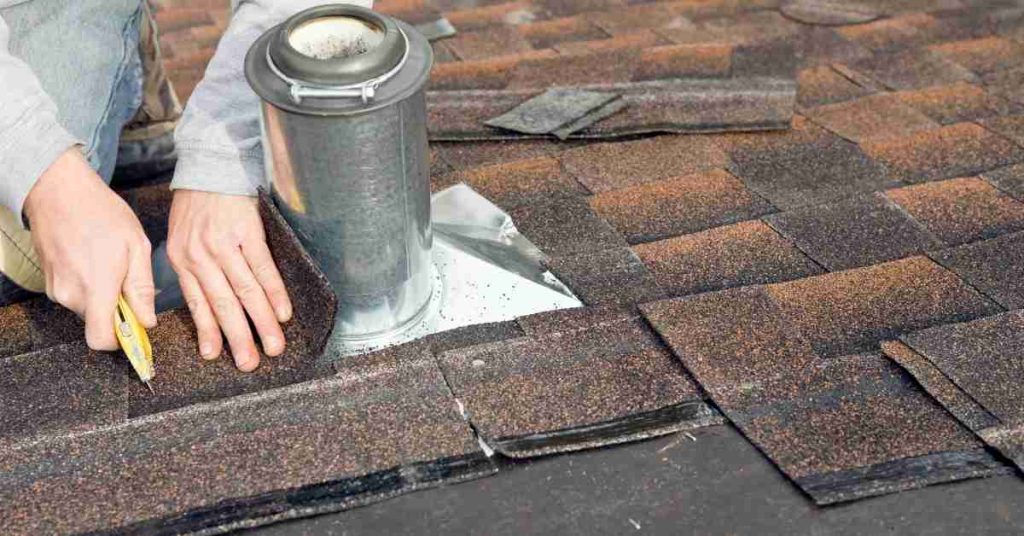
Plumbing vents are essential components of a plumbing system, playing a crucial role in maintaining proper drainage and preventing sewer gases from entering your home. Here’s a brief summary of what plumbing vents do, the types, sizes, and diagrams:
Plumbing Vents: What They Do
- Role: Plumbing vents serve to equalize air pressure within the drainage system, allowing wastewater to flow freely and preventing traps from siphoning. They also vent sewer gases safely outside.
- Preventing Siphonage: When water flows down a drain, it creates a vacuum that can siphon the water from nearby traps, leading to odors and potential contamination. Vents prevent this by introducing air into the system.
- Venting Sewer Gases: Plumbing vents extend through the roof of a building, allowing sewer gases to escape harmlessly into the atmosphere instead of entering the living space.
Types of Plumbing Vents
- Vent Stack: A vent stack is a vertical pipe that extends through the roof, providing venting for multiple fixtures on different floors. It’s a common type in residential plumbing systems.
- Individual Vent: Each plumbing fixture, such as a toilet or sink, can have its individual vent pipe that connects to the main stack or exits separately through the roof.
- Air Admittance Valve (AAV): AAVs are mechanical devices installed under sinks or behind walls to provide venting without the need for a traditional vent stack. They open to allow air in when needed and remain closed otherwise.
Sizes of Plumbing Vents
- Main Vent Stack: Typically, main vent stacks are 3 to 4 inches in diameter.
- Individual Vents: Individual vents for fixtures are typically 1.25 to 2 inches in diameter.
Plumbing Vent Diagram
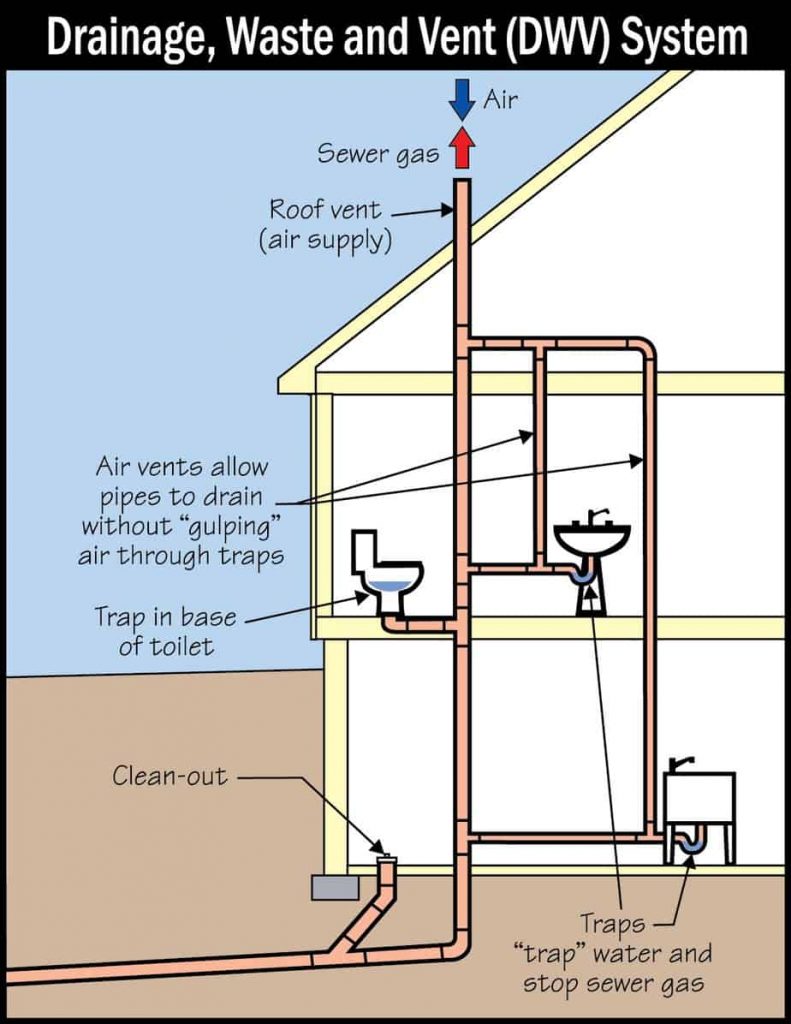
A house usually has one single and big vent stack which is connected to the main house drainpipe and runs through the roof of the house.
There are however many fixtures in a house (toilets, sinks, tubs, showers and washing machines) which all need to be vented. What happens in this case is that small vents called branch vents are used to connect each fixture to the main vent stack.
This is why it is possible to vent many fixtures using only one vent stack.
It is just the same way that each fixture has its own drainpipe which then drains into the main drain stack.
Why You Need It
Plumbing vent as I have mentioned serves 2 purposes:
- Remove sewer gases and odor out of the system
- Bring in air into the system
Now let us look at both of these functions in more details.
1. Removal of Sewer Gases
The moment waste leaves our drains, it becomes sewage, and as you already know, the smell of sewage is not that pleasant. There then needs to be a means to remove these gases from the drainage, and that is where the plumbing vent comes in.
But what prevents the sewer gases from coming straight through the sink or tub/shower drain?
Do you see the water at the bottom of the toilet bowl? That is what ensures that sewer gases flow out through the plumbing vent and not through the drains.
All the fixtures in your house have a U-shaped bend just under the drain opening, called a P-trap or drain trap. It is named as such since it resembles an inverted P.
You can see P-traps under your kitchen/bathroom sinks but cannot see the one in your tub/shower unless you have an unfinished basement.
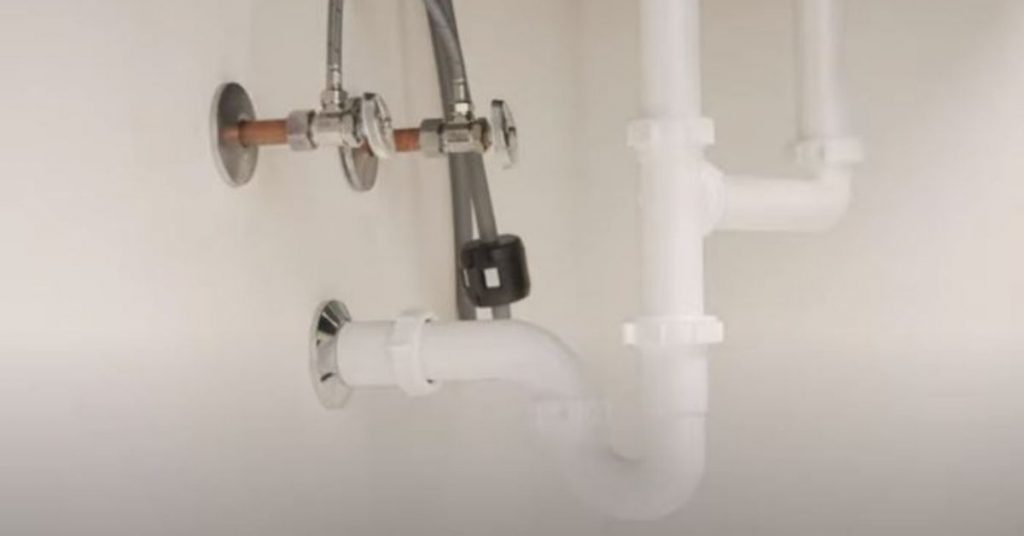
A P-trap has 2 functions. First, it traps potential drain clogs prevent them from clogging the drainpipe farther away. Unclogging a P-trap is easier than having to snake a drainpipe.
Secondly, a P-trap thanks to its shape is always full of water. This water acts as a barrier, preventing sewer gases from coming up through the drains. As a result, sewer gases always exit the system from the plumbing vent, unless it is clogged.
Any time you experience sewer gases in your house/bathroom it is very likely that the plumbing vent is clogged. As a result, sewer gases are being forced out through the drains.
You will also notice that your fixtures will be draining slowly and a gurgling sound will be heard during draining.
2. Introduction of Air into the Drainage
In order for you fixtures to drain efficiently and your toilets to flush strongly, you need to have air inside the drainpipe. Not a vacuum.
I will give you a common example to demonstrate to you how a vent improves how your fixtures drain.
Imagine you are draining your water heater. What do you do to help it drain out faster? You will either open the nearest hot water faucet or the T&P relief valve.
By so doing, you will be letting in air which will help push out the water faster and quieter.
Another example you can try is to pour water from a bottle. After a few seconds, take a knife and punch a hole through the bottom of the bottle (now facing up). You will notice that the bottle will drain out way faster.
Without a plumbing vent, you will have what is called negative air pressure in the drain system. Negative air pressure means pressure lower than the atmospheric pressure.
Negative air pressure in a non-vented, poorly vented or clogged vent happens as the water drains out rapidly, drawing in air to itself (entrainment). In simple terms, this means the creation of a vacuum inside drainpipe.
Since a vacuum cannot exist, it will try to pull air from the surrounding. The problem as we have already seen is that there is water (inside the P-trap) between the vacuum and the air surrounding the fixture.
As a result, the water in the P-trap will be siphoned out. This is why you will hear a gurgling sound from the bathtub or sink drain after flushing the toilet if the vent is clogged.
The gurgling sound is as a result of the water being siphoned out.
Since the water barrier has already been broken, sewer gases will as a result flow out of the drain without any restriction.
This is the same reason S-traps were banned in favor of P-traps. If you have always had a sewage smell in your kitchen or bathroom, check underneath the sink if you have an S-trap instead of a P-trap.
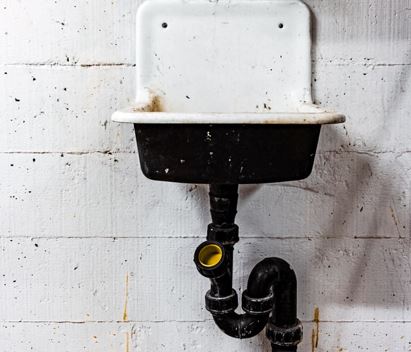
Unlike a P-trap which is connected to a horizontal pipe to allow in air during draining, an S-trap is connected to a vertical pipe. As a result, a vacuum is created in the vertical pipe during draining which siphons out water from the trap.
The point here is to always check your vent for clogs whenever you notice that your fixtures are draining slowly and toilets flushing poorly. The same could however be caused by a partially clogged drainpipe.
Always pour some water in your guest bathroom drains to replenish the one in the P-traps as it tends to evaporate allowing in sewage odors. Do the same also in all of your drains and flush toilets if you are coming back home from a long trip.
Plumbing Vent under Sink
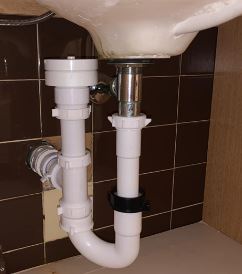
A plumbing vent under a sink is known as an air admittance valve (AAV). An air admittance valve is a short pipe with a valve at the top that allows air into the fixture drainpipe to help in draining as well as avoid siphoning of water from the trap.
It is one of the best ways to vent an island sink. It allows air into the drainpipe but will not allow sewer gases out. In a way it works like a check valve.
If you sink is not vented meaning it is draining slowly as well as allowing sewer gases through it, an air admittance valve is good way to fix the problem. It is cheap and easy to install.
Unlike the cheater vents used in trailers, air admittance valves are gravity-operated. They only open when the water draining out of the fixture creates a negative air pressure, and thus preventing the siphoning of water from the P-trap.
Although air admittance valves are accepted in most parts in the United States, you should first check the plumbing code in your area just to be sure that indeed you can install one.
While air admittance valve are great, they only work with small water volumes. A high-volume fixture that discharges 20 gallons per minute or more of waste may overwhelm it.
The Types
Venting in plumbing is not always easy and that is why it is heavily controlled by the building code. You just cannot install vents as you so wish.
Here are some of the main types of vents in plumbing that you need to be aware of;
1. Common Vents
Common vents simply refer to a concept that allows 2 fixture traps to be vented by the same vent. The 2 fixture traps can either be in the same level or different levels but they must be on the same floor.
In instances where a sink or shower are installed higher than a toilet ( albeit on the same floor), the drainpipe must have a diameter of at least 2 inches.
2. Waste Stack Vent
A waste stack vent refers to the practice of allowing the drain stack to serve as a vent. In this vent system, there needs not to have any offsets in the waste stack portion.
After the highest branch interval has been connected to the stack, the vent section of the stack can contain offsets as long as they are at least 6 inches from the branch.
Note that the size of the stack (diameter) should be maintained from the bottom to the point of termination or connection to another stack. This means that if the vent starts off as a 3-inch pipe, it should not suddenly shrink to a 2-inch pipe.
3. Wet Vents
If you want to reduce the number of individual vents for each fixture, wet venting is what you should consider. Fixtures are said to be wet vented when the vent is also used to carry waste from fixtures connected to the drain-waste-vent system at a higher level.
For instance, if your house has several floors, the vent for the fixtures downstairs will be used to drain waste from the fixtures upstarts.
Went venting can be used in both vertical and horizontal plumbing vents.
4. Circuit Vents
Circuit venting is a method of venting 2 to 8 trapped fixtures (fixtures with a trap) together instead of providing a single vent for each fixture. In this system, a vertical vent connects to horizontal branch where 2 to 8 fixtures are connected into a battery.
The flow of waste in the horizontal branch is slow and quiet, which prevents creation of pressure differentials which would otherwise affect the connected fixtures.
The slope on the horizontal branch should also not exceed 1 inch per foot to limit creation of turbulence.
For more information and diagrams on proper venting, check out this detailed guide.
Plumbing Vent Pipe Sizes Chart
| Size of Fixture Trap (Inches) | Slope (Inches/Foot) | Distance from Trap (Feet) |
|---|---|---|
| 1 1/4 | 1/4 | 5 |
| 1 1/2 | 1/4 | 6 |
| 2 | 1/4 | 8 |
| 3 | 1/8 | 12 |
| 4 | 1/8 | 16 |





